
The world’s largest land animal looms small in the distance. Photo by: Cyril Christo and Marie Wilkinson.
Africa’s elephant poaching crisis doesn’t just threaten a species, but imperils one of humanity’s most important links to the natural world and even our collective sanity, according to acclaimed photographers and film-makers, Cyril Christo and Marie Wilkinson. Authors of the book Walking Thunder – In the Footsteps of the African Elephant, Christo and Wilkinson have been documenting Africa’s titans in photos and film for several years. In 2011, the pair released a film Lysander’s Song (named after their son an avid fan of elephants) which depicts the millennial-old relationship between humans and elephants.
“The elephant inhabits our imaginations like few species in the history of our kind. We are probably indebted to elephants for having helped us survive droughts because they knew where to find water and when the rains would arrive. They are self-aware and they mourn their dead…they know who they are. They are the spirit of nature!” Christo and Wilkinson told mongabay.com in an interview. “Just as there is a movement among scientists and philosophers to give cetaceans non-human person status, so should the great apes and elephants. It is a question of morality, mind, ecology and spirit because a world without these beings invites a world that is no longer habitable for humans.”
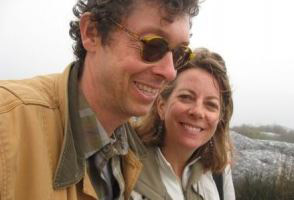 Cyril Christo and Marie Wilkinson. Photo courtesy of Christo and Wilkinson. |
Since the late 2000s, poaching of Africa’s elephants for their ivory has hit levels not seen for decades. Experts now warn that some 30,000 elephants are being butchered every year for their ivory, much of which is smuggled abroad to East Asia. The crisis, which has coincided with skyrocketing poaching of rhinos as well, has not only decimated populations of the world’s largest terrestrial animal, but has also changed elephant behavior, according to the filmmakers.
Response to the poaching crisis has been slow, but is beginning to pick up speed. In July of this year, U.S. President Barack Obama pledged $10 million to help African nations train wildlife rangers and police to mitigate the illegal trade. In addition, this week the U.S. has announced it will destroy it’s ivory stockpile. The U.S. remains one of the biggest destinations for ivory behind East Asian countries. Last year the Convention on International Trade in Endangered Species (CITES), which has been decidedly slow to address the crisis, put China, Thailand, Vietnam, Philippines, Malaysia, Kenya, Tanzania, and Uganda on notice: the eight countries must make progress on combating the ivory trade by summer 2014 or face sanctions on all wildlife trading.
But it’s not just governments that need to step up, according to Christo and Wilkinson, but people too. They encourage people to join the up-coming March for Elephants.
“Ours is a pivotal time for the biosphere. The elephant is its terrestrial monarch and without it a kingdom crumbles. […] People need to voice their concern and their outrage in the media, school children everywhere need to send petitions to politicians and their elders, to President Obama and to the President of China and remind them to continue the campaign to stop the ivory trade.”
Christo and Wilkinson are also the authors of a new photography book coming out in October: In Predatory Light.
INTERVIEW WITH CYRIL CHRISTO AND MARIE WILKINSON
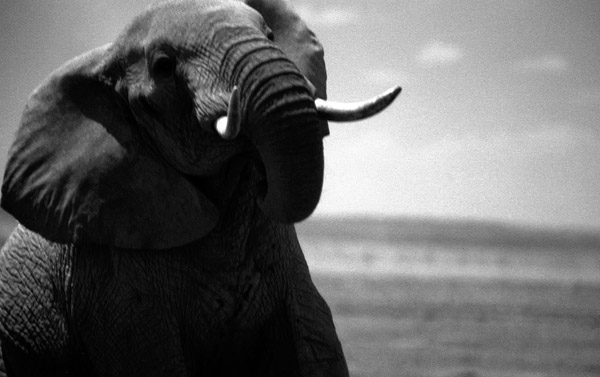
Although it appears indomitable, elephants are vanishing across Africa to poaching. Photo by: Cyril Christo and Marie Wilkinson.
Mongabay: Will you tell us about your background? How did you become photographers?
Cyril Christo and Marie Wilkinson: Marie and I have been recording stories and documenting the effects of climate change and globalization since 1997 on our first trip around the world and then again in 1999. We heard from native people the world over that rain patterns were changing and that droughts were increasing. Some of the starkest evidence of these changes can be witnessed in Africa where the relationship between the human species and wildlife is most evident. In Beryl Markham’s word’s Africa is a “photographer’s paradise” but it is also a thirsting purgatory and the origin of our species. Africa’s lessons are a testing ground for the planet.
Mongabay: What propelled you to take on advocacy for elephants?
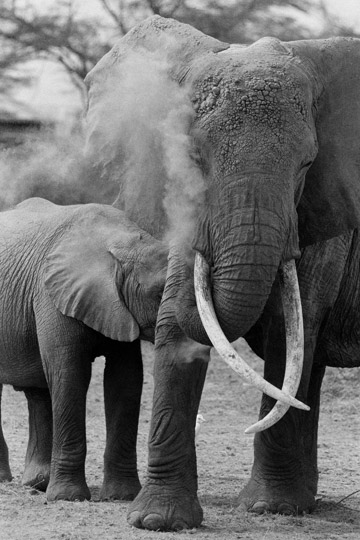 African elephants. Photo by: Cyril Christo and Marie Wilkinson. |
Cyril Christo and Marie Wilkinson: We wanted to pay homage to the greatest land mammal on earth, a being with whom we walked out of Africa. It is truly the being on terrestrial ground that inspires complete awe and wonder and it should command utter respect. In fact, in the Kalahari, a rabbi told us that the word pil, elephant in Hebrew, is the root of the verb pela, to wonder. Without the elephant we lose an essential pillar in the ability to wonder. With the elephant you are haunted and humbled for life.
In the few years leading up to our black and white homage Walking Thunder – In the Footsteps of the African Elephant, prologue by Dame Daphne Sheldrick, Merrell 2009 we learned that the second phase of poaching in contemporary history was underway. We all thought that the 1980s slaughter was behind us. We tried to tell the media in the last years of the last decade that a renewed menace to the elephant has started up again but no-one listened.
Eventually we went to Vanity Fair in the early summer of 2010. They deliberated for five months and finally sent Alex Shoumatoff to Africa in November of that year. He realized one of the most powerful pieces on a single species ever written. Agony and Ivory came out in August 2011 and went viral. It galvanized the world. The media world has caught up mostly recently with the powerful National Geographic cover story Blood Ivory (October 2012) but our morality, our ability to slay the innocent has not changed.
Mongabay: Why should people care about elephants?
Cyril Christo and Marie Wilkinson: The elephant inhabits our imaginations like few species in the history of our kind. We are probably indebted to elephants for having helped us survive droughts because they knew where to find water and when the rains would arrive. They are self-aware and they mourn their dead…they know who they are. They are the spirit of nature! Just as there is a movement among scientists and philosophers to give cetaceans non-human person status, so should the great apes and elephants. It is a question of morality, mind, ecology and spirit because a world without these beings invites a world that is no longer habitable for humans. But most of all they are ineffable and they are titans. They are walking miracles. As one ranger who lost his grandfather to an elephant, but who is also a tireless advocate for elephants told us, “A world without elephants is like a world without oxygen.”
Mongabay: Will you tell us about your short film Lysander’s Song? How do local tribes view the elephant?
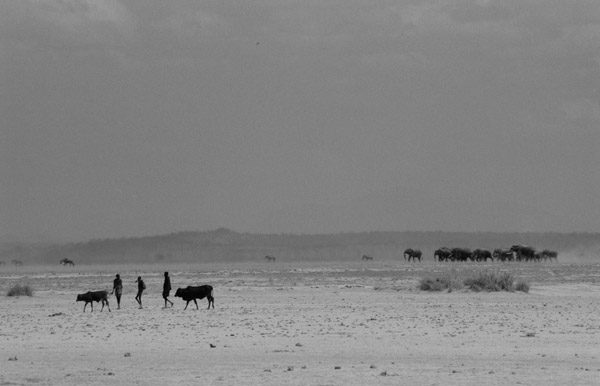
Humans and elephants have lived side-by-side for millions of years and still do in many parts of Africa and Asia. Photo by: Cyril Christo and Marie Wilkinson.
Cyril Christo and Marie Wilkinson: Apart from documenting Africa for the last 16 years, photographing and interviewing tribal elders, we realized we needed to make a visually moving prayer to the elephant and the native ethos of Africa. Lysander’s Song is a 25 minute attempt to bring together the human and elephant relationship as an elegy to the spirit of the oldest continent. In it we introduce Lysander, our son who first learned to walk on the plains of Africa. The film’s logo is “What does the future of the elephant have to do with the future of childhood? Everything!” If we do not save the elephant, an integral pillar in the childhood imagination, what on earth can we save? The film is also an homage to a being that some tribes honor, like the Samburu who have an elephant clan. The say there is a seed of a human being inside each elephant. They honor the elephant. They say that of all animals, humanity’s relationship to the elephant is the most important. They say that without the elephants “we will lose our minds, there will be nothing left to return to. The only thing left will be to kill ourselves.” It is a warning we need to heed before it is too late.
Mongabay: How has the poaching crisis changed the behavior of elephants in Tanzania?
Cyril Christo and Marie Wilkinson: In the Selous, the largest game reserve in Africa, we noticed very skittish behavior that we had not noticed before. Mothers would huddle and form the proverbial protective wall around their calves. Males would see us from 100 yards and turn around, wanting nothing to do with us. It was disarming, defensive behavior that made us realize us how intrusive we are as humans and how stressed elephants can become. We are altering elephant society. By eliminating bull elephants and by fracturing elephant families as a whole we are changing their culture as well. Other bull elephants in Kenya, Botswana, Zambia and other places would often greet us and at least not run away at first sight. Does the whole of nature have to fear the human animal?
Mongabay: What are the impacts for human-elephant conflict?
Cyril Christo and Marie Wilkinson: Poaching is a horrific adjunct to already strained relations between local Africans and wildlife and what remains of the wild. We began in the wild, in nature, although some people like the Maasai have no word for nature, they simply say the beauty of God or the Creator. Poaching exacerbates the relationship between not just indigenous groups and the wild but also ultimately our very place on earth. I think it is fair to say an Africa without elephants is a crippled continent on many levels, and Africa is where we began. Where indeed are we headed?
[U.S. Secretary of State] John Kerry realized the extent of the problem when he convened the Ivory and Insecurity meeting in D.C. last spring. He emphasized the ivory trade has global security implications and relations to terrorism.
Mongabay: How heartened are you by the recent U.S. interest in the poaching crisis?
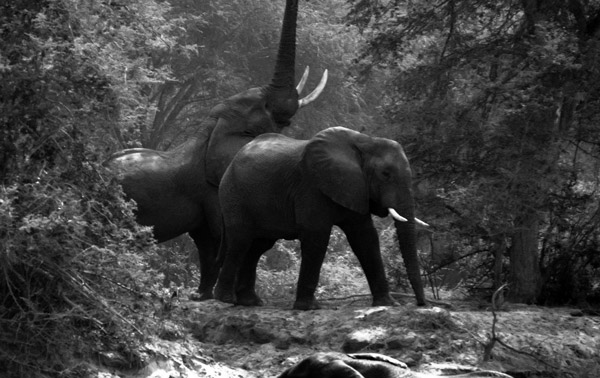
A pair of elephants. Photo by: Cyril Christo and Marie Wilkinson.
Cyril Christo and Marie Wilkinson: Generally America has barely covered the environmental news. We are the biggest culprit in climate change. What we need to realize is that while there have been media responses to the ivory situation there has been no great public outcry. No public outrage that we could lose the greatest land mammal on earth within ten years. No billboards like those in China saying to the world, no more ivory trade. America, make no mistake about it, is still in the business of decimating its wolves (an endangered species), it still wants to prospect for oil in melting Arctic seas where polar bears are half the weight they were ten years ago, our Navy is still blowing the ears of whales everywhere worldwide with their ear piercing sonar looking for oil deposits. We are turning a land that was a place of miracle and promise into a wasteland and the rest of the world is following our lead. We are still the second largest market of ivory on the planet. We are the ones who almost completely destroyed the great buffalo herds of tens of millions. We are the ones who totally extinguished hundreds of millions of passenger pigeons. Jewelers and art dealers who have no qualms in trafficking ivory are still being caught.
Overall the coverage of environmental news is still woefully inadequate. The U.S. remains a buyer of ivory and U.S. trophy hunters still destroy 600 lions every year. The lion population of Africa is not threatened due to the indigenous people of the continent. It is threatened by those in the first world who are barbaric and bored and who see no beauty in the life but to blow out the brains out of innocent beings.
The recent media attention for the elephant is vital but long overdue. This is the latest phase of destruction since the ivory ban of 1989. Most scientists thought that humanity had passed that stage of destruction. This is the second phase in less than 30 years and if the destruction continues at the rate of 30,000 a year, a being that inhabits our conscience like no other in history we could find ourselves in a situation where the elephant plummets like the gray whales back in the 19th century when they were almost totally wiped out and today there are only 25,000 or so.
The Last Stand of the African Elephant: a short film by Cyril Christo and Marie Wilkinson.
The recent NY Times article Killing Lions, Buying Bombs, the Financial Times piece on China’s potential as a force for conservation are evidence of the increased awareness. President Obama recently met with the President of Tanzania over the ivory trade and wildlife trafficking. But serious penalties have to be enforced throughout Africa and corruption at the highest levels stopped. The upcoming March for Elephants on October 4th in 13 cities, from New York, to Nairobi, to Cape Town, to DC, to Toronto to San Francisco, launched by the remarkable Dame Daphne Sheldrick in Kenya and the Sheldrick Wildlife Trust is the first march in human history for a non-human species. It signals a sea change in consciousness that we are not alone on this planet. What would be heartening would be for America with all its prowess and technical know how to lead the world in environmental awareness so that the over 50% of the population who do not believe in climate change, could realize that their children’s lives are changing now. That in less than a generation a being that emerged from a pig-sized creature 50 million years ago to become the greatest land being in the history of life could be a memory by the time 2nd graders finish high school. The Guardian once wrote a piece Animal Extinction is the Greatest Threat to Humanity because what is at stake is the entire ecosystem and bedrock of our civilization.
Until very recently America was an island nation unto itself with no real concern for the larger planetary realities it confronts, like the very real possibility that New York could be underwater by mid-century. We in America live in a bubble of our own making. Why not have an environmental channel from all over the world that shows us what is actually happening on planet earth? Why not have a mandatory year long ecology course in every school and university in the nation? We will soon be an irrelevant, post industrial backwater with no fauna to speak of. What bedtime stories will we be reading children then? Babar anyone?
Heads of state and law enforcement officials need to understand that this is not just about wildlife, this is a battle for the life force. Our foreign policy will soon be guided by the environmental realities of the globe and our environmental policies have been fantastically short-sighted. In order to think seven generations ahead, as the native people have long recommended, we need to care for the environment as if our lives depended on it, not just as a resource base or as something that is a side bar to our normal lives. The environment is everything.
Mongabay: What needs to be done to truly tackle the poaching crisis in Africa?
Cyril Christo and Marie Wilkinson: Penalties need to be increased from a few months in jail to thirty years or a lifetime. The killing of an elephant needs to be seen as a high crime on par with criminal syndicates who sell arms and drugs and not just a misdemeanor. The wildlife trade reaches into the billions of dollars annually and it is not a renewable resource. Paltry fines of a few hundred dollars doesn’t accomplish much. We propose fines of many hundreds of thousands of dollars as is being contemplated in Kenya. But the law must be enforced. Cooperation between countries need to be seriously increased everywhere. But the source of the problem is the demand and desire for luxury item, for tusks that many in the Orient believe simply fall out like milk teeth.
The greatest problem is an intangible perception. Most Chinese don’t realize that elephants have to be slaughtered indiscriminately for ivory. Maybe it is easier to willfully ignore the realities. Last year over 30,000 were destroyed for toothpicks and trinkets. A being that is a deity in India is being made into baubles! The media campaigns led by IFAW and WildAid throughout China, need to continue and be magnified. The Chinese need to know that they are losing face in the world mind. The shame they are bringing upon themselves is global.
Their children will want to see or at least know that elephants continue to exist. The major transformation or conversion has to happen in the heart of the middle Kingdom, because now world conservation truly revolves around the biggest country on earth. Instead of losing face for all time, China can become a monumental force for conservation and she should. The future of the world depends on it!
Mongabay: What can people do to help elephants?
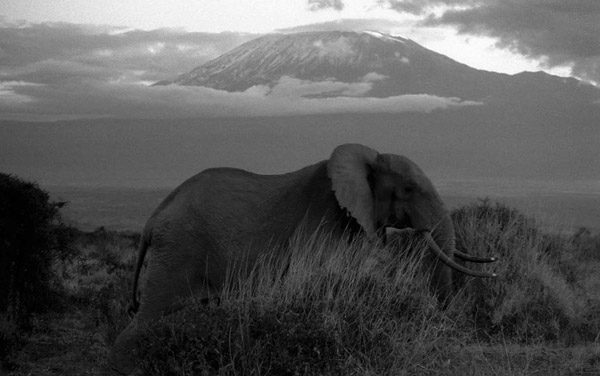
Imagine a world without elephants… Photo by: Cyril Christo and Marie Wilkinson.
Cyril Christo and Marie Wilkinson: Every capable citizen should help Save the Elephants, the Tusk Trust and the David Sheldrick Trust. People should join the upcoming March for Elephants and make sure to make their voices heard beyond this global event and to see it through until the ivory trade is finally stopped like slavery in its heyday.
Ours is a pivotal time for the biosphere. The elephant is its terrestrial monarch and without it a kingdom crumbles. The elephant is huge but we need to see in this greatest exemplar of life a way of conducting ourselves on the globe that is humble. Elephants are overpowering but they form a chain with the entire chain of being, with the chain of life from the most delicate frogs, to the strongest 3,000 year old baobab trees. People need to voice their concern and their outrage in the media, school children everywhere need to send petitions to politicians and their elders, to President Obama and to the President of China and remind them to continue the campaign to stop the ivory trade. One eight year old from Colorado, Isabella, started a petition on Avaaz that says, “Can you imagine a world without elephants?” What will the prospects for humanity be if that occurs? I truly believe that civilization will stand or fall on the back of the African elephant. Or as Romain Gary once wrote,” Whoever has seen these giants moving across the last open spaces of the world knows that this is something that must not be lost.”
Most of all people need to be creative and reach out in ways they have not conceived because in some essential way, our lives, at the very least, our souls are on the line.
It was best summarized by the writer and visionary Romain Gary in his masterpiece The Roots of Heaven: “In an entirely man made world there can no room for man either. All that will be left of us is robots.”
Related articles
U.S. to crush its six ton ivory stockpile
(09/10/2013) On October 8th, the Obama administration will publicly destroy its ivory stockpile, totaling some six tons, according to a White House forum yesterday on the illegal wildlife trade. The destruction of the stockpile—via crushing—is meant to send a message that the U.S. is taking a tougher stand on illegal the wildlife trade, which is decimating elephants across Africa and imperiling other animals worldwide. The U.S. remains one of the biggest destinations for ivory and other illegal animal part aside from East Asia.
Elephant killer gets five years in prison in the Republic of Congo
(08/01/2013) The Congolese Supreme Court has ordered Ghislain Ngondjo (known as Pepito) to five years in prison for slaughtering dozens of elephants for their ivory tusks. The five year sentence is the maximum in the Republic of Congo for poaching. Ngondjo was considered the “kingpin” of an elephant poaching group; in addition to killing pachyderms, Ngondjo recruited new poachers and made death threats to park rangers and staff in Odzala National Park.
Zoos call on governments to take urgent action against illegal wildlife trade (photos)

(07/24/2013) In a single night in March, a band of heavily-armed, horse-riding poachers slaughtered 89 elephants in southern Chad, thirty of which were pregnant females. The carnage was the worst poaching incident of the year, but even this slaughter paled in comparison to the 650 elephants killed in a Cameroon park in 2012. Elephant poaching is hitting new records as experts say some 30,000 elephants are being killed every year for their ivory tusks. But the illegal wildlife trade—estimated at $19 billion—is not just decimating elephants, but also rhinos, big cats, great apes, and thousands of lesser-known species like pangolins and slow lorises. This growing carnage recently led to representatives of over 40 zoos and dozens of wildlife programs to call on governments around the world to take immediate action on long-neglected wildlife crime.
No sweat: elephants living with people aren’t stressed

(07/23/2013) Nature preserves, wildlife sanctuaries, national forests, parks, grasslands and protected areas are the cornerstones of conservation. These are the wild places where animals can still dwell, grow, and reproduce in their natural environment without any human-caused stressors. While many of these special places have facilitated leaps and bounds for wildlife conservation, the reality is that these areas are extremely limited and most plants and animals live beyond, or must migrate out of, their bounds.
Hunting, logging could threaten long-term health of Congo forests by wiping out key animals
(07/23/2013) Unsustainable hunting of forest elephants, gorillas, forest antelopes, and other seed-dispersers could have long-term impacts on the health and resilience of Congo Basin rainforests, warns a study published today in a special issue of the journal Philosophical Transactions of The Royal Society B. Conducting a review of more than 160 papers and reports on trends in wildlife populations, hunting, and land use in the Congo Basin, an international team of researchers conclude that unless effective management plans are put into place, hunting pressure in the region is likely to increase, with knock-on ecological effects.
Deforestation rate falls in Congo Basin countries

(07/22/2013) Deforestation has fallen in Congo Basin countries over the past decade despite a sharp increase in the rate of forest clearing in the Democratic Republic of the Congo, according to a new study published in the Philosophical Transactions of the Royal Society B as part of a set of 18 papers on the region’s tropical forests. The special issue, which was put together by Oxford University’s Yadvinder Malhi, covers a range of issues relating to the rainforests of the Congo Basin, including deforestation, the impacts of global change, the history and key characteristics of the region’s forests, and resource extraction, among others.
Obama to take on elephant and rhino poaching in Africa
(07/03/2013) Barack Obama launched a new initiative against wildlife trafficking on Monday, using his executive authority to take action against an illegal trade that is fueling rebel wars and now threatens the survival of elephants and rhinoceroses. The initiative, announced as the president visited Tanzania on the final stop of his African tour, was the second time in a week Obama has used an executive order to advance environmental policy, after announcing a sweeping new climate change plan.
New forensic method tells the difference between poached and legal ivory
(07/01/2013) Forensic-dating could end a major loophole in the current global ban on ivory, according to a new paper in the Proceedings of the National Academy of Sciences (PNAS). Scientists have developed a method to determine the age of ivory, allowing traders to tell the difference between ivory taken before the ban in 1989, which is still legal, and recently-poached ivory.
Authorities nab ringleader of poachers who killed 89 elephants in Chad
(06/27/2013) During one night in March, horse-riding poachers slaughtered 89 elephants in Chad, including over 30 pregnant mothers. Now officials say they have caught the ringleader behind the mass-killing: Hassan Idriss, also known as Gargaf.
